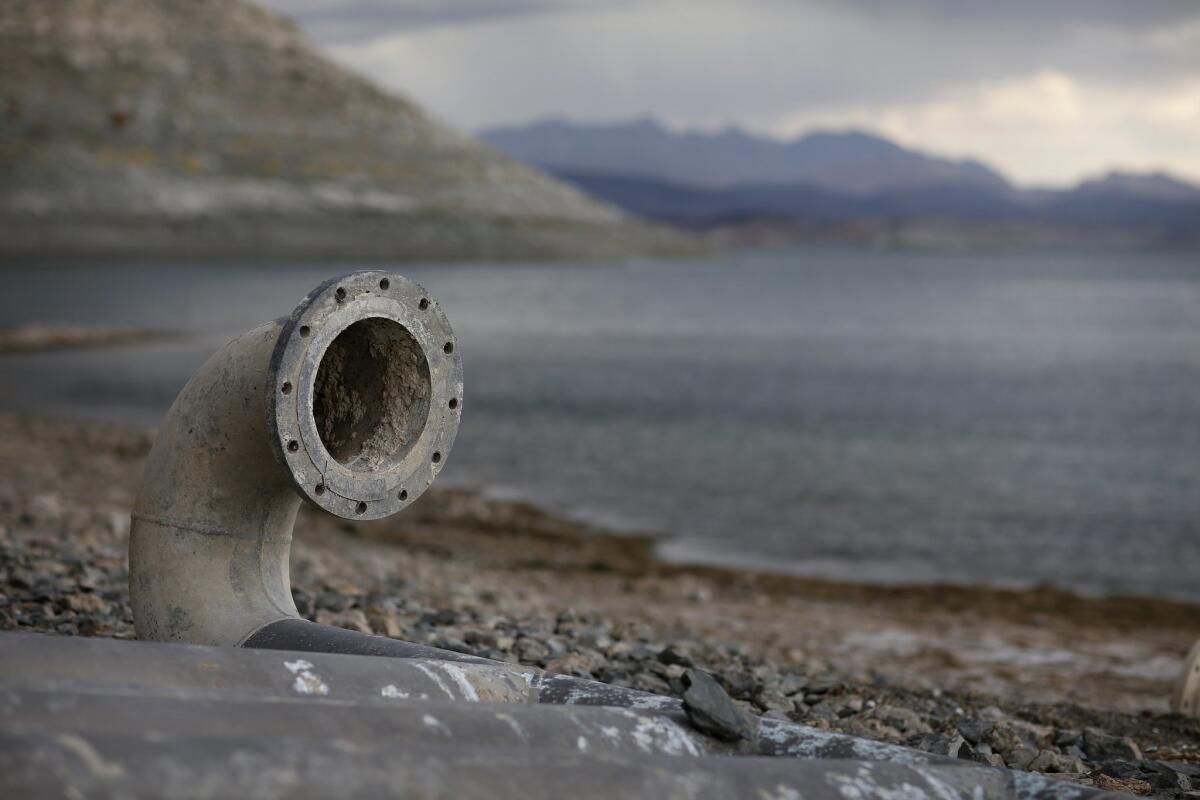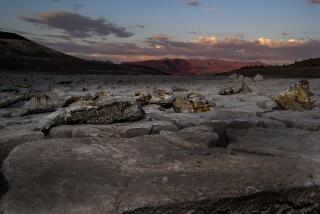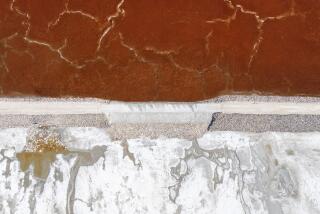Op-Ed: It’s not just a ‘California drought’

Water intake pipes that were once underwater sit above the water line along Lake Mead in southern Nevada on May 18. For the last several years, drought has persisted in much of the West and the Great Plains.
In a somber opening to wildfire season this month, federal and state officials meeting in Nevada warned that kindling-dry forests and a rainless forecast could lead multiple states in the Great Basin to erupt in flames at once, stretching firefighters and equipment thin across the region.
For the last four years, vast swaths of four Great Basin states — Nevada, California, Oregon and Utah — have been baking in extreme or exceptional drought. That’s actually rather brief in comparison with the 15-year water shortage punishing the Colorado River basin. Drought has persisted, too, in the southern Great Plains. Parts of Texas and Oklahoma had been enduring the most arid conditions since the Dust Bowl — until, in early May, rain finally began to fill reservoirs and quench parched ground.
Dryness stretches throughout the American West. Yet the nation is captivated by the notion of a “California drought.” Headline writers, network news anchors and radio broadcasters have all rallied around that label, as if drought and its life-changing impacts — wildfire being only the most dramatic — stopped at Golden State lines.
“The problems are integrated across states,” says John Fleck, writer in residence at the University of New Mexico’s Water Resources Program. “And the solutions are integrated across states too.”
Along the Colorado River basin, what began as a welcome string of sunny days in 2000 has become one of the longest-lasting droughts in modern American history. The nation’s largest reservoir, Lake Mead at Hoover Dam, is also our largest symbol of a crisis unnoticed in plain sight. Dipping slowly to reveal deeper and deeper bathtub rings, Lake Mead this month set a record low — the first time since it was filled in 1936 that its surface dropped under 1,080 feet. Millions of visitors have straddled the Nevada-Arizona line to snap photos of the chalky rings; most haven’t seemed to see the big-picture implications.
Scientists for nearly 15 years have raised the specter of “mega drought” — the sort tied to the collapse of civilizations from the Mesopotamians to the ancient Pueblo peoples of the Colorado Plateau. Americans, however, accustomed to a seemingly endless supply of relatively cheap water, have been slow to reckon with drier, harsher realities.
Silent to arrive and slow to reveal their darkest sides, droughts notoriously fail to attract the attention they deserve relative to devastation. This is especially true in the Third World. Humanitarian systems that can quickly rally the world to aid flood disasters were maddeningly slow to respond to the 2011 drought in the Horn of Africa. Oxfam estimates that tens of thousands of deaths could have been avoided with a swifter international response.
In the United States, unlike the iconic hurricanes that churn in on unforgettable names such as Camille, Hugo and Sandy, it is rare for droughts to earn themselves a handle. For years, former Nebraska Gov. and U.S. Sen. Ben Nelson named the droughts that burned into the Great Plains to try to win them more exposure. He christened a David, followed by an Edna, but his labels never caught on.
In contrast, the California drought is a veritable brand. It’s finally impossible to ignore the water shortage because it’s affecting one of the world’s largest economies, home to more Americans than any other state at 39 million. Gov. Jerry Brown’s call for a 25% reduction from the water-supply agencies that keep showers jetting and sprinklers whirring made international news.
“It was as if Jerry Brown said, ‘Let there be drought,’ and finally, there was drought,” observes Christiana Peppard, a scholar who specializes in environmental ethics at Fordham University.
Now, politically correct Easterners are suddenly pondering water ethics, from landscape design to food choices. The New York Times is keeping the story on its front pages, if oddly at times: The May 3 Sunday Review cover asked if it’s “The End of California?,” while the same day’s Style cover declared “Los Angeles and Its Booming Creative Class Lures New Yorkers.” Inevitably, the New York Post sent paparazzi flying over the Oz-green California estates of the Kardashians and Barbra Streisand for celebrity lawn shaming.
People who think long term about water and climate change are just happy that Americans are engaged in the conversation. “It is so difficult to get across this connection between the water that comes out of your tap and how nature provided that water,” says Kelly Redmond, deputy director at the Desert Research Institute’s Western Regional Climate Center. That’s particularly true in places where water flowing from the faucet originated in snow that fell hundreds of miles away.
“The California drought has finally helped people make that connection,” Redmond says. “Drought is the classic crisis and opportunity, and we have been able to use it in that sense.”
Indeed, the California drought gave Brown the political cover to pass the first groundwater-pumping regulations in state history. The need to protect California’s aquifers has been obvious for nearly a century; photographs reveal the drama of land subsidence from over-extraction in the San Joaquin Valley beginning in the 1920s. But it took apocalyptic language and cracked-earth images of the modern California drought to break the power of the agricultural lobby.
Widespread awareness is often the path to change amid the arcane traditions of Western water law. Almost all of the landmark changes to the Law of the Colorado River that divided the water among seven U.S. states and Mexico in much wetter times have taken place in the wake of flood or drought. That includes the 2007 water-sharing pact that calls for Arizona and Nevada to curtail their use of the river should the surface of Lake Mead drop below 1,075 feet.
If that happens, and it might soon, it will serve as a stark example of how water shortage ripples beyond state borders, Fleck says. The reservoir is so low in part because, as the California drought worsened last year, Southern California’s Metropolitan Water District was able to almost double the amount of water it drew from the Colorado via legal tools such as paying for conservation in other places.
Drought’s consequences also reach beyond the Western states, to grocery stores and East Coast pastureland.
Western water scarcity has drawn attention to the fact that California produces half the fruits, nuts and vegetables grown in the nation, and heightened concerns about the sustainability of industrial agriculture in a warming world.
“You have people talking once again about what is in the California almonds or the pint of strawberries from the Manhattan grocery store — about whether they are ingesting nonrenewable water from California’s Central Valley,” Peppard says. “So if a national debate about almonds can be the moment when we realize how agriculture is structured in the United States — how the issues are both ecological and moral — that is a good thing.”
Longer term, persistent drought could push more water-intense crops and livestock from the arid West to the relatively wet East, where many regions are dealing with the twin water woes of scarcity and pollution. As drought has reduced cattle herds across the West, some Eastern states — including Indiana, New York, Ohio and Pennsylvania — have seen an increase in cattle numbers.
Several news articles in recent weeks have suggested that Southern cotton-growing states are ideal places to absorb California crops — with no mention of the water strife that plagues the region.
Rice cultivation in Arkansas over the last century has depleted the Mississippi River Alluvial Aquifer by 90 feet. Water has been so mismanaged among Florida, Georgia and Alabama that the states have spent 20 years and millions of dollars fighting in court, when they could have been working together to use less.
Growing the right crops in the right places is a worthwhile goal. But simply moving the problem of over-extraction from one region to another is not the answer.
“Understanding the complexities of drought, and American water issues, and the broader scale to climate — these are dialogues we need to have whether we’re in Atlanta or Nebraska or California,” says Michael Hayes, director of the National Drought Mitigation Center at the University of Nebraska. “We are in need of a paradigm shift that is broad, that spans society, instead of a few exceptional communities saying we want to be innovative, productive and resilient. We want to be all of that as a nation.”
We can call it California’s, but this drought is America’s.
Cynthia Barnett is the author of three books on water. Her latest is “Rain: A Natural and Cultural History.”
Follow the Opinion section on Twitter @latimesopinion and Facebook
More to Read
A cure for the common opinion
Get thought-provoking perspectives with our weekly newsletter.
You may occasionally receive promotional content from the Los Angeles Times.










